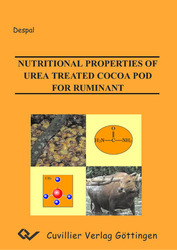| Areas | |
|---|---|
| Serie de libros (96) |
1378
|
| Nachhaltigkeit |
3
|
| Gesundheitswesen |
1
|
| Letra |
2362
|
| Ciencias Naturales |
5406
|
| Matemática | 229 |
| Informática | 319 |
| Física | 980 |
| Química | 1363 |
| Geociencias | 131 |
| Medicina humana | 243 |
| Estomatología | 10 |
| Veterinaria | 108 |
| Farmacia | 147 |
| Biología | 835 |
| Bioquímica, biología molecular, tecnología genética | 121 |
| Biofísica | 25 |
| Nutrición | 45 |
| Agricultura | 1004 |
| Silvicultura | 201 |
| Horticultura | 20 |
| Ecología y conservación de la tierra | 148 |
| Ciencias Ingeniería |
1790
|
| General |
97
|
|
Leitlinien Unfallchirurgie
5. Auflage bestellen |
|
Erweiterte Suche
Nutritional Properties of Urea treated Cocoa Pod for Ruminant (Tienda española)
Despal Despal (Autor)Previo
Indice, Datei (110 KB)
Lectura de prueba, Datei (230 KB)
Three series of experiments have been conducted in order to evaluate the potential of cocoa
pods as a feedstuff for ruminants.
The first study comprised five treatments (C = cocoa pod fresh; U0 = ensiled without urea; U1, U2 and U3 = addition of urea 10, 20 and 30 g/kg fresh cocoa pods respectively and then ensiled) and three replications in a complete random design. It was found that ensilage improves the feed value of cocoa pod by weakening the ligno-cellulose or –hemicelluloses bonds, resulting in higher in vitro gas production, as well as higher calculated organic matter digestibility (OMD) and metabolisable energy (ME) contents compared to the fresh cocoa pods. The protein value of cocoa pods, expressed as true protein (TP) or non ammonia nitrogen minus urea-N (NAN-UR) was also improved. Additions of urea affected the composition of the fibre fraction as to the proportion of NDF, ADF and ADL and the content of TP was slightly increased. However, (NAN–UR) was lower than in the non urea treated ensiled samples. Urea treatment increased Gb and calculated OMD and ME compared to ensiled or fresh cocoa pod.
The second experiment aimed at investigating the effects of replacing a barley/soybean mealmixture by urea treated cocoa pod in feed rations on methane release, SCFA production as well as the amount and efficiency of microbial-N fixation in Rusitec. The experiment included six different rations (T1 = 10 g/d hay; T2 = T1 + 4 g/d barley-soybean mixture (barley); T3 = T1 + 3 g barley + 1 g cocoa pod); T4 = T1 + 2 g barley + 2 g cocoa pod; T5 = T1 + 1 g barley + 3 g cocoa pod; T6 = T1 + 4 g cocoa pod) and three runs of Rusitec in a block random design. Cocoa pod was treated with 20 g urea per kg fresh material.
In the third experiment, two methods for the determination of microbial protein synthesis (MPS) in Rusitec were applied and compared. With both methods stable isotope nitrogen (15N) served as a tracer. The direct measurement of microbial-N in bacteria isolates resulted in higher MPS compared to the indirect method based on N-turnover in the ammonia pool. The results obtained are compared and discussed in relation to theoretical stoichiometric data of rumen fermentation.
| ISBN-10 (Impresion) | 386537347X |
| ISBN-13 (Impresion) | 9783865373472 |
| ISBN-13 (E-Book) | 9783736913479 |
| Idioma | Alemán |
| Numero de paginas | 116 |
| Edicion | 1 Aufl. |
| Volumen | 0 |
| Lugar de publicacion | Göttingen |
| Lugar de la disertacion | Göttingen |
| Fecha de publicacion | 16.02.2005 |
| Clasificacion simple | Tesis doctoral |
| Area |
Agricultura
|








